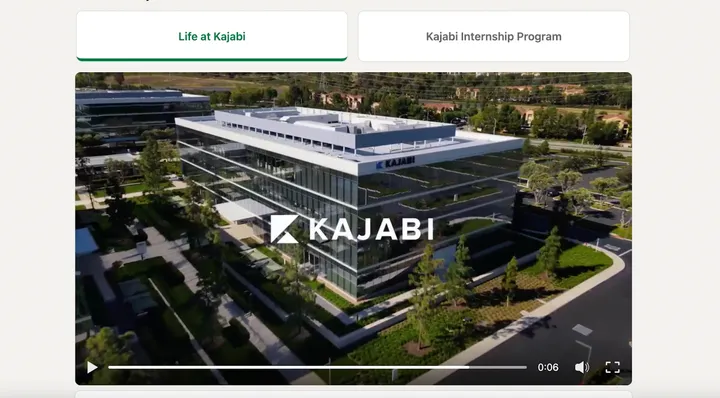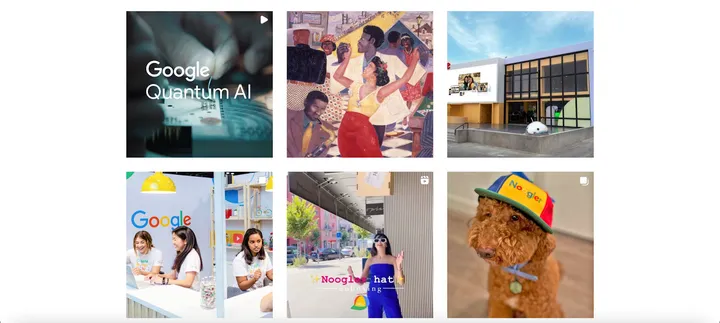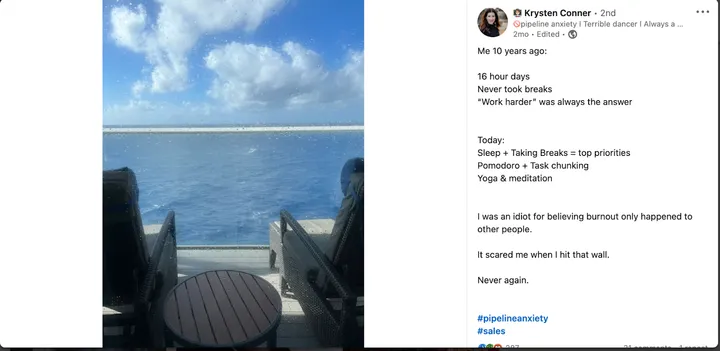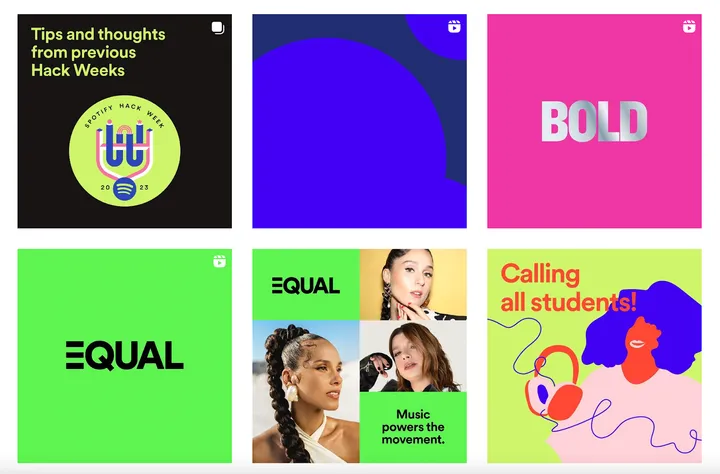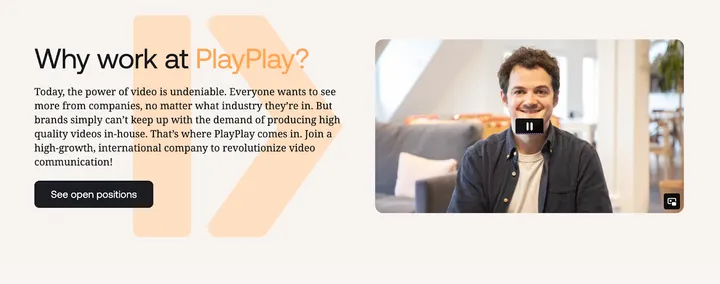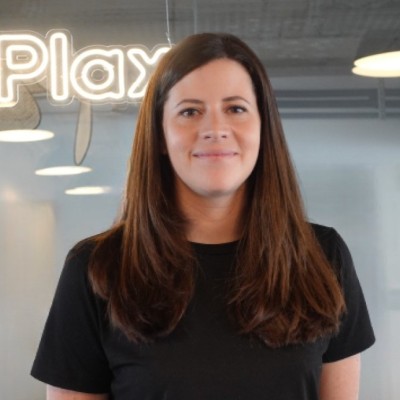If you were searching for a new role today, where would you look? Probably social media first, then job boards before finding your way to the company’s website.
You’re not alone – it turns out that more than half a million people use social media platforms like LinkedIn to find open roles.
So what does that mean for employers?
Great news! Maintaining an active employer brand on social media will help you connect with high-quality candidates faster than publishing lengthy job postings on your website — where they might get buried forever.
Fortunately, you don’t need to go through a social media video agency to create stunning content for your platforms!
In this article, we’ll walk you through all you need to know about building a strong brand image on your social media posts and share examples to inspire you.
Recruit the best talent with employer branding
Discover how to build a strong employer brand on social media with video to attract and retain A+ talent.
Get the guide Why use social media for employer branding?
Social media is the best place to connect with A+ candidates and show them why they should work for you. Don’t just take our word for it — let’s look at the data:
- In the US, eight people are hired every minute on LinkedIn,
- Ninety job applications are submitted on LinkedIn every second and,
- 54% of Gen-Xers and 68% of Millennials will look at your social media accounts before applying for the role.
The trend is clear. If you’re not building an employer brand on social media, you’re missing out on an opportunity to engage with prospective employees, have a steady pipeline of quality talent, and fill open roles quickly.
5 examples of employer branding accounts on social media
Let's take a look at five companies embracing social-led employer branding.
1. Kajabi
Kajabi taps into the power of employer branding videos. Besides driving 800% more engagement than plain text, videos leave a lasting impression on A+ candidates and pique their curiosity about your company.
The first thing you find on Kajabi’s Life page is a 48-second employer branding video. The video is a series of quick scenes showcasing the trusting relationship between Kajabi employees, their work-life balance, and their amazing office space.
If you scroll down the page, you’ll find yet another video on Kajabi’s culture. Here, employees talk about the company’s mission, exciting challenges, and what they love most about working at the company. This is a good play because people are more likely to believe what your employees say about your company than your own branded content.
And for those who do not have the time to watch videos, Kajabi highlights written employee testimonials and several company photos showing their team at work.
2. Google
The Life at Google page gives you a 360-degree overview of what working with the tech giant looks and feels like. It covers a range of content — from employee spotlights to office tours and CSR initiatives.
What we love most about this page is how it shows Google’s culture in practice. For example, it regularly highlights diverse groups of Googlers and how the company supports them in doing their best work. You’ll also see how Google’s perks — like onsite wellness centers and the work-from-anywhere policy — help their employees achieve better work-life balance.
As a bonus, the page offers many recruitment and interview tips, including first-hand advice from current Googlers using the hashtag #mypathtogoogle.
3. UserGems
On its Instagram page, UserGems spotlights new employees — what they love to do, why they joined the company, and fun facts about them. The company also celebrates employee milestones like work anniversaries.
UserGems is big on employee advocacy too. Team members regularly share content around how UserGem’s culture and values help them avoid burnout and achieve better work-life balance — like this post:
4. Spotify
The first thing you notice on the Life at Spotify page is how colorful it is — seriously, have you seen a more beautiful display of colors?
Similary to Google’s page, this page gives prospective employees a feel of Spotify’s culture. It features diverse employee spotlights, highlights from company initiatives, office tours, and several Spotify awards like this one.
Also it’s worthy to note how Spotify uses videos for authentic storytelling. For example, instead of sharing image highlights from its summer internship programs, Spotify put together a short video where participants talk about their experiences, why they chose the company in the first place, and what’s next for them. Employer branding videos provide a more personalized way of communicating the benefits of their internship.
5. Oktopost
Oktopost doesn’t have a dedicated employer branding page on social media. But its employees do a great job with advocacy.
For example, new hires share a short get-to-know-you video that covers why they joined the company, their hobbies outside of work, and the exciting challenges they look forward to in their new role.
Employees also share “a-day-in-my-life” videos showing how they spend their days off every month. These videos capture Oktoposters’ diverse experiences and how the company allows them to thrive no matter where they live.
5 types of employer branding content
Don’t bore your audience with only one type of employer brand content. Combine different content types and formats to improve your employer branding strategy.
1. Recaps/roundups
Recaps highlight your company’s achievements over a specific period — like a month or a quarter. It’s a great way to show what your organization has been up to and give prospective employees an idea of what you’ll focus on in the coming days.
You can publish these roundups on your blog and post highlights on social media. But video creation is our tried-and-true method at PlayPlay.
Every quarter, we share interesting videos showcasing the work our team has been doing. It helps us highlight the humans behind our brand and build genuine connections with our audience.
Like PlayPlay, you can create high-quality roundup videos in only 15 minutes. Get started with our simple video creation tool with the 7-free day trial.
2. Day-in-my-life videos
What started as a trend on TikTok has now become one of the most effective types of employer branding content.
Day-in-my-life videos show an employee’s typical workday — how they prepare, what they do in the office, and what happens after work. These videos work well because of their authenticity, light-heartedness, and creativity.
Apart from showing your company culture in action, day-in-my-life videos also give candidates a realistic idea of what their role might look like at your company.
For inspiration, check out this day-in-my-life video from Spotify.
Curious about how to effortlessly create employer branding videos? Look no further than PlayPlay's video maker, the ultimate platform for crafting professional and engaging content.
3. Recruitment videos
Job posts with videos have a 34% greater application rate than those without. Videos work well for recruitment because they are more personalized, engaging, and capture candidates’ attention.
Buffer is a great employer branding example of a company that uses recruitment videos to its advantage. For its Growth Product Manager role, Buffer shared a TikTok video where the hiring manager talked about the perks of working at Buffer, the salary range, and the qualities of their ideal candidate.
Buffer’s employer branding recruitment video was so effective that the company received over 3,000 applications for the role. The lesson? The best recruitment videos are authentic, get straight to the point, and have a clear call to action.
Learn more about creating quality recruitment videos that capture the attention of A+ candidates.
4. New-hire introductions
When someone joins your team, share a blurb on social media highlighting their role, experience, and hobbies outside of work. They'll love it, and it'll ease their new-hire anxiety.
Even better, ask them to record a short video where they introduce themselves to the team (and your social community). Getting a feel of the human behind the list of well-written accomplishments makes it easier for the old and new employees to bond with each other. This is even more important in remote companies with few in-person interactions.
5. Employee takeovers
Employee takeovers are pretty similar to “a-day-in-my-life” videos. Only this time, the content is delivered in real-time instead of in a curated version.
Typically, an employee “takes over” the company’s social accounts for a specific period of time, usually a day. They can share short videos about their workday, share photos with their teammates, or even go live to answer questions from the audience.
Within three months of launching employee takeovers, Kuno Creative’s Instagram account added 450 followers and its weekly engagement rate increased by 17.4%. Like them, you can achieve amazing results by incorporating employee takeovers into your overall employer branding strategy.
Download our latest guide to discover more types of employer branding content for your social accounts.
5 tips for building your employer brand on social media
After looking at these examples, you might be thinking, “My company needs to pull this off.” The good news is, you can!
There’s no magic wand for great employer branding, especially on social media. But small and consistent steps make all the difference.
Here are five simple steps to get you started.
1. Craft your employer brand message.
Your brand message is the single narrative you’re selling to your audience. In other words, it’s what you want people to think whenever they come across content related to your brand on social media.
Employer branding content can easily go out of scope, especially when multiple stakeholders are involved. When this happens, a clear brand message will help everyone realign with the original narrative and stay on track.
You need to define your unique selling points to craft a compelling brand message. Think about what makes your company stand out from the competition. Monetary rewards are part of this, yes. But you should also consider intangible factors like career opportunities, work-life balance, and DEI policies.
Once you've defined what sets your company apart, try to capture these key differentiators in a few words. At PlayPlay, for example, our brand message focuses on how we’re helping companies to communicate better using high-quality videos.
Also, where appropriate, inject some personality and emotion into your message to make it more human. A little humor here and there never hurts.
2. Create your brand voice
Brand voice is how you pass across your employer branding message. Two companies might have the same employer narratives but different brand voices. And they’ll ultimately attract different types of candidates.
For example, Tinder and Thursday are dating apps with distinct voices. Thursday is witty, and it sounds like you’re chatting with a friend in a coffee shop. While Tinder has a relaxed but formal tone.
A good brand voice matches your ideal candidate’s personality. In other words, you need to talk the way your audience talks. Say you’re appealing to GenZers. In that case, your tone should be light-hearted, quirky, and might even feature the latest pop culture references. On the flip side, if you’re targeting older millennials, your tone should be “business-casual”.
3. Use employee advocacy
Data from our employer branding guide shows that messages have 561% more reach when they come from an employee’s social account than your brand’s.
To win at employer branding, you must make the most of your greatest asset: People. There are many ways to get your employees to share positive content related to your company on social media:
- Hold regular workshops where you educate employees about the benefits of employer advocacy
- Amplify employee advice content on your internal communication channels
- Incentivize the process to encourage employee participation
In all, the best way to turn your employees into strong brand advocates is by being a great place to work. If you treat your employees well, they will share their positive experiences with others — without you even asking.
4. Post consistently
Consistency earns you mindshare with your target audience. The more prospective employees see and engage with your content, the more likely they are to apply to your job openings.
To achieve consistency, you need a social media content calendar — a schedule of what you'll post and when. If you have many stakeholders, assign different content days to them and communicate ahead of time so they can stay on track.
5. Engage with your audience
You’re having a friendly chat with someone. They keep talking about themselves and ignore you. Soon enough, you’ll lose interest. The same applies to employer branding on social media.
Social media is a two-way street. If you’re constantly putting out content but ignoring your audience, they’ll quickly lose interest and move on to other accounts.
Interact with your audience. Answer their questions or refer them to sources where they will find answers. Like the posts you’re tagged in and respond to comments. These actions show that you care about their opinions and gives your audience a sense of belonging.
Tailor your employer branding strategy to each social media platform.
Each social media platform is unique. So, you must adapt your employer branding approach to naturally fit your channel of choice. For example, bite-sized written content (threads) do great on Twitter; videos work well on Instagram, and LinkedIn likes carousels.
Take time to understand each platform’s algorithm, tailor your content to what works and stay true to your brand message and voice — that’s the only way to succeed!
In our employer branding guide, we dive deeper into the hooks and tricks of creating employer branding content that wins on different social channels — including Linkedin, TikTok, Twitter, and more! Get it now to transform your employer branding strategy, attract top talent, increase retention and maximize ROI.
Louise Antonas
Head of Recrutment
With 12 years' experience in recruitment for major French groups. At PlayPlay, Louise is responsible for a team of 5 people, covering an international scope to recruit from our offices in Paris, New York and Berlin.



